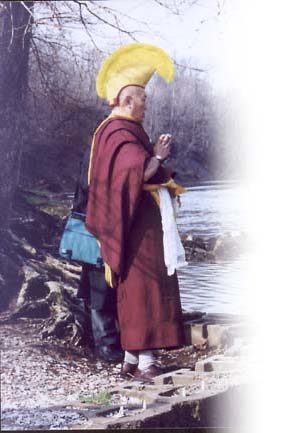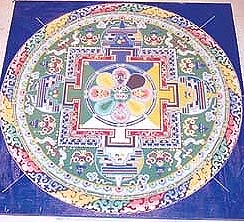
"Nothing is permanent in life, and you don't know
what will happen moment-to-moment."

"It will spread to other parts of the world and
bring peace. It is not just for us to enjoy."
Learn more about the Tibetan Center in Chicago.
Magazine
Summer/Fall 2001
Beauty, However Fleeting...

Art Howe '82 remembers how tough second semester can be at Wabash,
when students feel both the stirrings of spring and the pressures of nearing
finals. The Chicago attorney hoped to offer a respite, and some insight,
through connections he and his wife, Susan, have nurtured with that city's
Tibetan Center.
So for five days in April, hundreds of students, faculty, and townsfolk
witnessed the creation of a sand mandala by a senior Buddhist monk from
the Dalai Lama's Namgyal Monastery in Dharamsala, India. Surrounded by
the sounds of Tibetan music, the tinging of prayer bells, or a restful
silence, visitors watched intently as the Venerable Ngawang Chojor lightly
rubbed metal chaqpurs together to draw the fine lines of the mandala with
colored sand.
"Making the mandala is a form of meditation for the monk, who must
sit all day and concentrate," Tashi Puri of the Tibetan Center explained.
"It acts as meditation for the viewers as well."
The monk finished the mandala after almost 52 hours, and on Friday afternoon
a capacity crowd pressed into the College's Permanent Collection Gallery
to witness a celebration of the impermanent nature of art.
"Nothing is permanent in life, and you don't know what will happen
moment-to-moment," Puri explained. "That's what this ceremony
is about: the artwork is beautiful, but it's the discipline and enlightenment
that's important, not the art itself."
Chimes rang, the monk chanted, and the past 52 hours of creation were
swept into an urn. That sand was spread over the waters of Sugar Creek
moments later.
"It will spread to other parts of the world and bring peace,"
the monk explained. "It is not just for us to enjoy."
Professor David Blix '71, given
the honor of placing a prayer cloth over the monk during the ceremony,
said student time with the monk was an extraordinary learning experience.
The dismantling ceremony's dramatic demonstration of beauty's ephemeral
nature had been difficult for some to watch, Blix said: "It was really
very moving."
Religion professor Hall Peebles,
who has traveled extensively to religious shrines in Asia, said he'd never
witnessed such a ceremony.
"It's funny, but I've traveled to China several times, and to Tibet,
but to see a mandala created and dismantled, I had to come to Wabash."
Return to the table of contents
